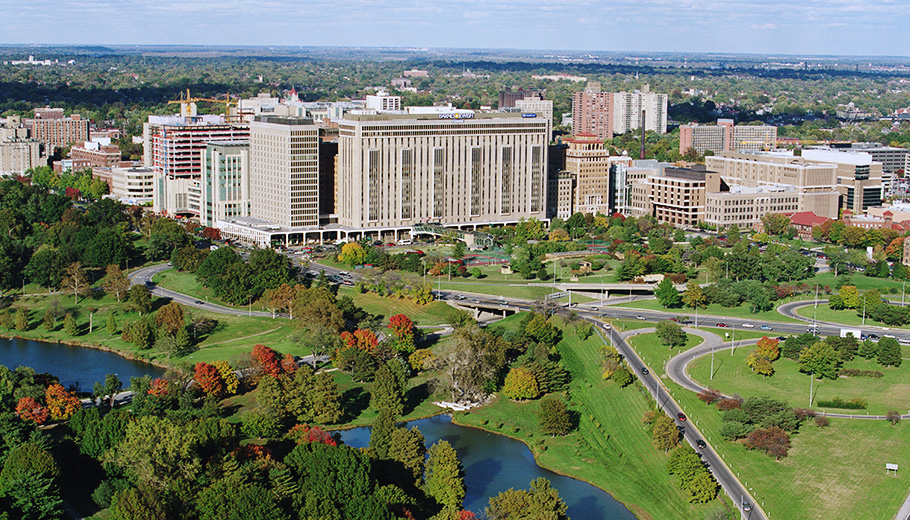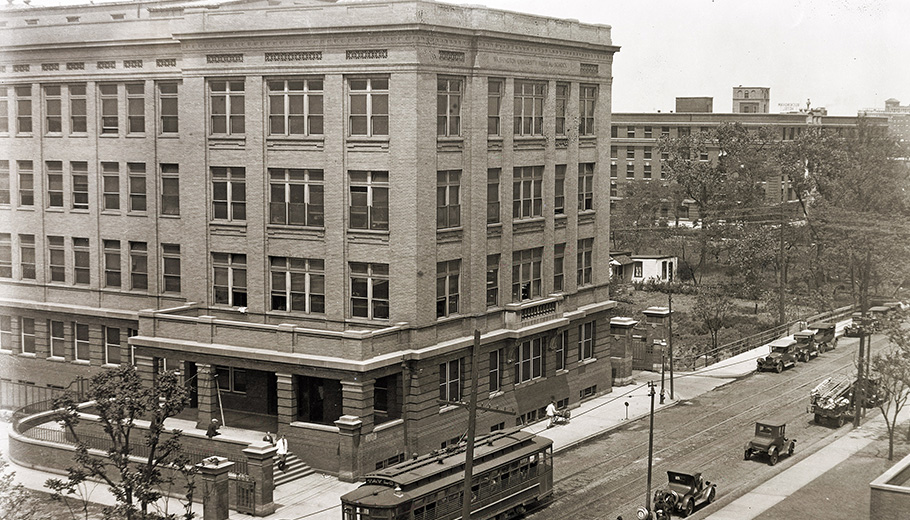The Washington University Medical Campus is located along the eastern edge of Forest Park in St. Louis’s Central West End neighborhood.

The Medical Campus includes Barnes-Jewish Hospital, St. Louis Children’s Hospital and the Alvin J. Siteman Cancer Center at Barnes-Jewish Hospital as well as Washington University School of Medicine in St. Louis.
The 10-year Campus Renewal Project currently underway at Washington University Medical Campus will transform the campus experience.
Explore locations on the Medical Campus.
Get parking and transportation information for the Medical Campus.
See information for Medical Campus patients.
History of the School of Medicine
The education of physicians at Washington University in St. Louis began in 1891.
Under an ordinance enacted April 14, 1891, establishing a Medical Department of Washington University, the St. Louis Medical College (an independent medical college in St. Louis) was brought under the wing of the well-established university.
The faculty of the college eagerly agreed to the union, stating “Most of the great medical schools of the world have always been integrant departments of universities, and the examples which America furnishes give added testimony to the fructifying influence of the contact of students and teachers of professional schools with the workers in universities.” Eight years later, the Missouri Medical College (another independent college in the city) also joined Washington University, and thus the two most famous medical colleges in the city were merged with the university.
In 1909, Abraham Flexner began a survey of 155 medical schools in the United States and Canada for the Carnegie Foundation for the Advancement of Teaching. The survey created a national sensation. Some schools collapsed, others pooled their resources, while still others reorganized. The Medical School of Washington University did not escape criticism. In the report Flexner made to Dr. Pritchett, president of the Carnegie Foundation for the Advancement of Teaching and former professor of astronomy at Washington University, he said that one of two courses must be adopted: “The department must be either abolished or reorganized.”
Dr. Pritchett mailed the report to Robert S. Brookings, a St. Louis merchant who was president of the Board of Directors of Washington University. Brookings was shocked and immediately went to New York to see Flexner, demanding proof that the conditions were as bad as described. Both returned to St. Louis and the two men went through the school. In less than two hours, Brookings was convinced that drastic action was necessary if the school was to be one of the foremost institutions of medical education and research. The meeting in 1909 of Brookings and Flexner was of unsurpassed significance in the history of the Washington University School of Medicine, for it led to the complete reorganization of the school and the establishment of the present Medical Center. Abraham Flexner inspired the dream of a model medical school. Robert Brookings accepted the challenge, and with the energy and vision which characterized all his enterprises, made the dream a reality.
No time was lost in making changes. The Bulletin of the Medical School for July 1910, made the following statement:
“The Corporation of the university, becoming convinced that in no other direction could greater service be rendered than through a great, modern medical school, determined to reorganize the school and to place it in the front rank of American medical institutions. It has called to the heads of a number of leading departments the ablest men it could secure.”
When Robert A. Barnes died in 1892, he left a will which directed the trustees of his estate to use $840,000 for the erection and equipment of a hospital “for sick and injured persons, without distinction of creed, under the auspices of the Methodist Episcopal Church, South.” Investigation by the trustees into the cost of building a modern hospital convinced them that the sum was not large enough to build an efficient, fireproof building, and they therefore invested the trust. By 1912 the value had increased to $2 million, a sum which permitted the building of a hospital and left an endowment greater than the original fund.

At the same time the trustees were studying hospital construction, Robert Brookings was studying medical schools. It was apparent to everyone concerned that the two projects, the building of a medical school and the construction of a modern hospital, were so interrelated that the purpose of each would be more successfully fulfilled by an affiliation. A medical school would provide a highly trained staff and would assure the most modern methods and superior laboratory facilities for the hospital. A teaching hospital would give patients superior care and, at the same time, provide the essential clinical experience consistent with modern medical teaching methods.
In the spring of 1912 construction was begun on the medical school and hospital buildings which today form the nucleus of the present center. The laboratories were moved from their old quarters in downtown St. Louis into the new buildings on Euclid and Kingshighway during the summer of 1914, and late in the fall of the same year the activities of the Washington University Hospital were transferred to Barnes Hospital. Concomitantly, the St. Louis Children’s Hospital, then located on Jefferson Avenue, became affiliated with the School of Medicine and moved to its new quarters in the Medical Center.
On April 28, 29, and 30, 1915, exercises were held to celebrate the completion of this group of buildings designed to promote the practice, the teaching, and the progress of medicine. The dedication ceremonies marked what Dr. William H. Welch of the Johns Hopkins University called “one of the most significant events in the history of medical education in America.” Robert S. Brookings, the one man most responsible for the reorganization, voiced the hope that
“Our efforts will contribute, in some measure, to raising the standard of medical education in the West, and that we will add, through research activities, our fair quota to the sum of the world’s knowledge of medicine.”
These prophetic words have been realized. Nineteen Nobel laureates have been associated with the School of Medicine, and 12 have been elected fellows of the National Academy of Sciences.
In the ensuing years the Medical Center has continued to grow, and now its facilities are among the best in the world. With the increase in the size of the physical plant there has come a substantial increase in the number of the faculty; the expansion has been made without compromise to the standards which marked the early development of the Medical Center. As a result, significant achievements in both research and clinical areas have been steadily recorded.
from the Centennial Bulletin of Washington University School of Medicine, 1991/1992